
May 8th 2007
Well, back at work today, but I really want to get a bit more of the holiday online, so here's another diary entry. Tomorrow is looking rather more hectic (I only have one student today), so there may well be a pause after this, unless I can get all the way to the end of the holiday today. Let's see.
Matsushima
Matsushima, which means "pine tree islands", is one of the more obviously derived place names in Japan. It's a bay on the northern Pacific coast, with 260 small islands, mostly covered in pine trees. It is regarded as one of the three most scenic spots in Japan, and that is certainly not an unreasonable claim; it is very beautiful.
We had quite a bit of rain on the day when we were travelling from Tsuru no Yu to Matsushima, but as we were only travelling that wasn't a real problem, and it all cleared up by the evening. We got the shinkansen from Tazawako to Sendai, then a local train from Sendai to Matsushima, then a tourist bus from the station to the hotel. Actually, the last bit was walkable once we knew the way, and on our full day (the Thursday) we did walk.
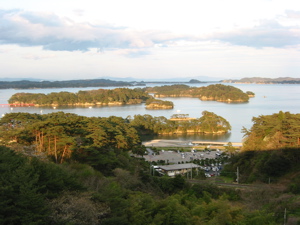 The evening view from our window in the hotel in Matsushima.
The evening view from our window in the hotel in Matsushima.
In Matsushima we stayed at Hotel Taikanso. The view from our room was absolutely amazing. On the other hand, I booked it about a year ago, and paid umpty-mumble yen for it, so the view was supposed to be amazing. It is fortunate that it lived up to expectations. The hotel was also nice. Dinner was a seafood buffet, and breakfast was also buffet-style. The service was good, and everywhere was clean. However, it was very definitely a big hotel; it felt a bit impersonal and corporate. I'm happy that we went there, and would recommend it to people with the appropriate budget, but I'm not planning to go back; it didn't feel like a lovable hotel.
The seafood buffet was good, with lots of sashimi, tempura, crab, and grilled ox tongue. I am aware that the last is not, strictly, seafood, but it is a local speciality of the area, so they really have to provide it. The breakfast buffet was also good, although I preferred the evening one.
I had booked two nights in Matsushima, so we had a whole day to look around. Fortunately, Thursday's weather was glorious. I had to put my jacket in a coin locker, because I would have been too hot walking around with it on. The first thing we did was get on a bay cruise, to go around and look at the islands from the water. Golden Week is the season for Matsushima, so we queued up a bit early and, as a result, got seats next to a window, which was helpful in seeing things.
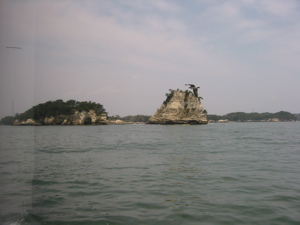 A couple of islands, from the boat.
A couple of islands, from the boat.
The cruise takes about fifty minutes, and goes briefly outside the bay, where the Pacific Ocean is a bit rougher. However, since we had nice weather, even that wasn't much of a problem. For the first thirty minutes or so there is a constant commentary, in English and Japanese, explaining all the islands. The English version was very much abbreviated from the Japanese, which was quite amusing. The Japanese commentary would say things like "This island was said to be as good as a castle by the first feudal lord of the area, so it is called "There is a castle island".", while the English was "This is Zaijoujima".
Most of the 260 islands are very small and uninhabited, but a few of the larger ones do have residents. A couple share a primary school and a middle school between them, with the pupils taking boats to get to school if it's on the other island. Missing the boat must be a real pain, as must days with bad weather. Actually, that made me wonder about living on the islands in bad weather: I wonder what it's like when a typhoon hits? There aren't so many that far north, but they do happen most years.
The boat was followed on its cruise by seagulls, and Yuriko went out on the rear deck to watch them, and take photographs. You can buy seagull food on the boat, which is, I imagine, why they follow it. Yuriko didn't actually feed them, but she did get a couple of nice pictures. I stayed inside to look at the islands and listen to the commentary. The last bit of the cruise was without commentary, giving everyone a chance to just enjoy the view. Of course, it was also quite close to the starting point, so there probably wasn't much new to explain anyway.
From the cruise, we went up into the town to see some of the other tourist attractions. The first was a tea shop, which specialised in little mochi balls (mochi is pounded rice) with three sauces: sesame, sweet soya sauce, and one I can't remember. Yuriko will know, though, because she really enjoyed them. So did I, come to that; they were very Japanese, and the tea shop, a preserved fisherman's house, had a highly appropriate atmosphere.
The next attraction was Zuiganji. This is a temple, built by the Date (dah-teh) clan in the Edo period. The Date were one of the most powerful daimyo families, and the founder, Masamune, is particularly famous; he was blind in one eye, but still one of the greatest generals of the period. The temple was built, and decorated with wall paintings, in his time. That means that the paintings are Momoyama period; that's the period in Japanese art when they gilded everything. The ones in the temple are restorations, I think, although they aren't very clearly labelled. There are two reasons why I think this. The first is that they are very clear and bright for paintings that are over four hundred years old. The second is that some of the originals are on display in the temple's museum. The whole structure, including the paintings, is a national treasure, and it isn't hard to see why.
Next to the temple is a long cliff, running much of the way down to the sea. The stone around Matsushima is very soft (which is, of course, part of the reason there are so many islands), and the cliff has numerous caves and Buddhist images carved into it. In the past, I imagine that Buddhist monks practised various kinds of asceticism in the caves, but now they are mainly attractions for the tourists. You can't actually go into them any more, unfortunately, but apparently people used to carve their names in the rock, so they closed them.
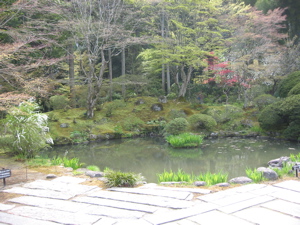 The pond in the garden at Entsuuin.
The pond in the garden at Entsuuin.
Our next stop was another temple, Entsuuin, which is next to Zuiganji. This is a converted villa, like the temples of the Golden and Silver Pavilions in Kyoto. Actually, there are quite a few similarities, one of which is that the main feature is the gardens, not the building. While the gardens are not as extensive and impressive as those of the Silver Pavilion, they are extremely nice, with a pond, and stone-and-sand garden... and a formal rose garden.
The rose garden is, however, probably not a later addition. In the early seventeenth century the Date lords sent an embassy to Europe, to speak to the Pope, and the ambassadors brought roses back with them. The roses were planted in the garden, and this was about the time when it was being laid out as a villa. Thus, the very regular rose area, with its nicely-trimmed square hedges, is probably an original part of the design of this four-century-old Japanese garden.
It still looks decidedly odd.
From there, we went to the fish market, because Yuriko wanted to eat some lunch. We shared a raw-tuna-on-rice dish, which was very nice, and then headed out for our next bit of sightseeing.
For this, we walked to some of the islands. There are bridges. Obviously. The first three are very small and close to the coast, and, in fact, I could probably have jumped from one to another. Maybe. The island furthest out has a temple to Benzaiten, and all the islands are supposed to be a holy area. Thus, the bridges were built with substantial gaps between the boards of the walkway. In fact, the gaps are as wide as the boards. There are thin, continuous, strips are well, but however you cross, you have to concentrate on where you are putting your feet. This is supposed to distance you from the mundane world, and put you in a more spiritual frame of mind.
Outside Golden Week, it might actually work. In Golden Week, however, the vast number of tourists on the islands makes it rather hard to feel very spiritual about anything. This was actually about the only place where I felt the number of tourists detracted from the experience, which, given how crowded Kakunodate was, is quite impressive.
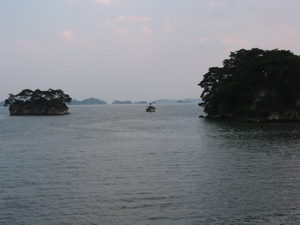 A view of some islands, from Fukuurashima.
A view of some islands, from Fukuurashima.
The next stop was Fukuurashima. This island is about 250 metres from the shore, and the bridge is a toll bridge, at least during the day. That cut the number of people down. In addition, there is nothing particularly famous on the island: it's a park. That cut them down more. As a result, Fukuurashima was fairly quiet, and we spent a nice hour or so walking around, enjoying the view. Because the paths go around the edge of the island, you can see a lot of the other islands from it, so we got a lot of very nice evening views.
Most of the island is wooded (pine trees, of course), but there are some beaches, and also a grassed area with benches and seats. Yuriko and I both really liked it; it was a very nice park indeed, and I recommend walking over to it if you visit Matsushima.
By the time we finished there, my feet were quite tired, and it was getting towards dinner time, so we headed back to the hotel, up the really steep slope. I think a full day is pretty much the ideal length of time to spend in Matsushima: enough time to see everything without hurrying, but also no sense of hanging around with nothing to do.
Talking of time, I think I can get away with finishing the holiday off.
Sendai
The last place we visited was Sendai. This is the largest city in Tohoku, and thus not an obvious tourist destination. However, we had to change trains there to get back to Tokyo, and we weren't getting the Shinkansen back until about 5:30, so, as we had finished in Matsushima, it seemed like a good plan to take a look around Sendai. In addition, Yuriko had realised that it gave her a chance to visit a contemporary art place that she'd sent a lot of flyers to and thought that she'd like to see.
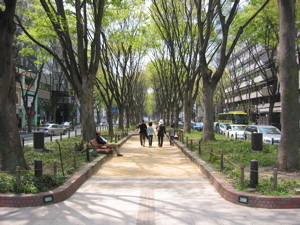 A view down the centre of the main road in Sendai.
A view down the centre of the main road in Sendai.
Sendai is a very nice city, so I'm glad we did stop off. It calls itself "City of Trees", and there are, certainly, a lot of trees there, even right in the centre. One of the main roads is very wide, with trees down each side and a tree-lined footpath down the centre. We walked along that to get to the art place, Sendai Mediatheque, and despite being a main road in a city centre, it was very pleasant. Apparently, the whole thing was the brainchild of the mayor, about thirty years ago, and he pushed through plans to knock down the buildings, widen the road, and then rebuild. According to Yuriko, the people at the time thought he was crazy, but I imagine the current residents are very glad he did it.
Sendai Mediatheque is a modern glass building, although it's rather more interesting than a simple box. It contains the city library and an information centre, as well as several art galleries on the upper floors. There was an exhibition of photographs of children at one of the city nursery schools, which we both found more interesting and engaging than we might have done, say, six months ago. Can't think why...
From there, we walked on down the road, until it came to a park by the river. We walked through the park, found the old city library, and speculated on possible future uses for the building, finally settling on "our house". As Yuriko pointed out, the bookshelves would already be installed, which is convenient. For lunch, we had the grilled ox tongue again. It was very nice, nicer than the version served at Matsushima, but then it is really a Sendai speciality.
That still left us a few hours, so we went to the most recommended tourist attraction in our book. To get there, we decided to take "Sendai Loople", the tourist bus. It was packed. Tokyo rush hour underground packed. So packed that, one stop after we got on, the driver radioed in to say that he was full and wouldn't be picking up any more passengers. When we got to the next stop, which was where we were getting off, there was a long line of people waiting for the bus. This provoked spontaneous laughter, of the sort that you get when a plan is so obviously not going to happen that it becomes funny... I don't know what those people did, but the Loople is not really up to the Golden Week load.
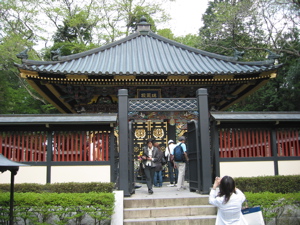 The reconstructed mausoleum of Masamume Date.
The reconstructed mausoleum of Masamume Date.
Anyway, the attraction itself was the mausolea of the Date clan. These were fine examples of Momoyama art, like a small version of Nikko, and were designated national treasures in 1926. They were also completely destroyed in US air raids in 1945. They were, however, reconstructed, in part, in the 1970s, at considerable cost. Extensive surveys had been done before the air raids, so the reconstructions are quite accurate. The process also provided an opportunity for some archaeology, and the remains and grave goods of the first Date lord were found, which are now on display. (Primarily grave goods, rather than remains.)
The mausolea are on top of a hill, and the hill is planted with cypresses. These are quite clearly more than sixty years old, and so must have survived the air raids; the atmosphere of the steps up the hill is very pleasant indeed. In fact, I think it was my favourite bit of the site, and I think Yuriko agreed.
We were going to walk back to the station, but a regular bus going there turned up at a bus stop just as we did, so we got on and rode instead. Then we had a coffee, picked our bags up from left luggage, and got the Shinkansen, underground, and bus home.
All in all, it was a really, really good holiday. As it will be our last holiday as a couple for years, that's a very good thing. I'm pretty sure we will go back to Tsuru no Yu, at least, taking Yudetamago. But that, of course, will be a very different experience.